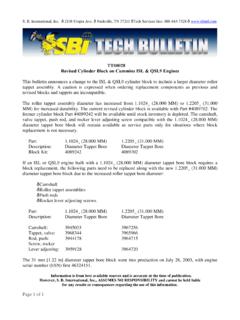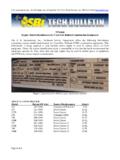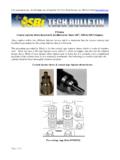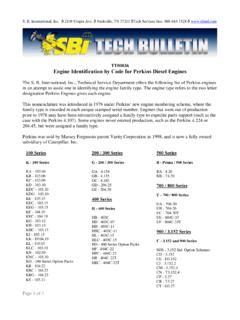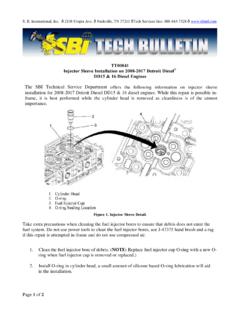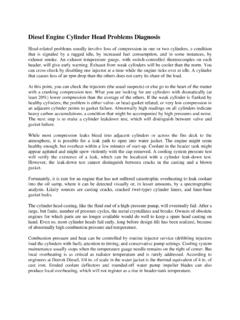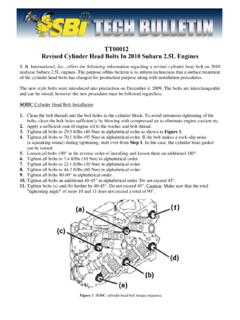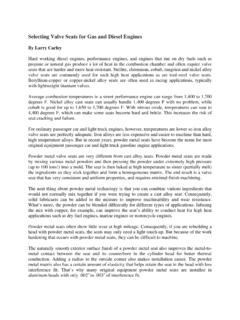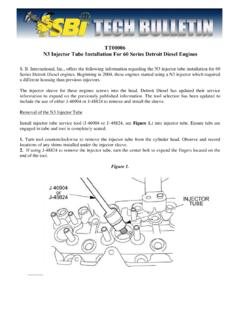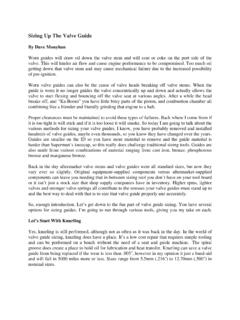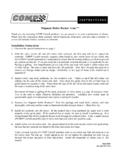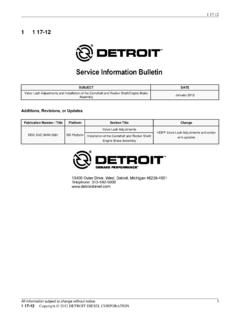Transcription of rocker arm geometry - sbintl.com
1 20 APR-JUN 2010engine professionalROCKER ARM geometry seems to raise its head every now and then, and when it does, I rarely ever see it stated accurately. Too often a sound bite of only a small piece of information is taken out of context and then used as the Gospel, totally ignoring the other dynamics that revolve around it. In some cases, something totally erroneous is stated that is not only wrong, but makes no sense for anyone who just stops and thinks about it lecturing at trade shows, schools, engine shops or just getting pinned down on the phone by a knowledgeable engine builder going deeper than most on a technical issue, I have found that I spend about half my time trying to undo various misconceptions about rocker geometry before I ever begin explaining the facts.
2 There has been so much info put out there by reputable companies (and by my reckoning, incorrect), that people are reluctant, by nature, to see something different from the prejudice of what they already know or think they know. If people are used to doing something a certain way, they see everything from that perspective. Usually, my getting through to them involves discrediting what I think is wrong with what they were doing and then begin to explain what they needed to change. At that point I could break down the simple rules for what geometry really is, and of rocker GeometryRocker geometry (or the lack of it), goes way back to many fathers on both sides of the ocean, to when the Wright Brothers were still studying the theories of lift in an airfoil.
3 But for our purposes here, and to avoid boring the curious who ve managed to get this far on this story, I ll come to the point about rocker arms and explain as needed how the mistakes got to where they the old days, rocker arms were all pretty much what we term a shoe design; meaning the contact pad with the valve had a large radius scruff surface that depressed upon the valve tip as the rocker moved through its rotation. The term of course comes from the appearance to a shoe s sole, but also to the mechanical motion much like a foot and boot would do, as it pushes off. This pushing off motion, as many will already know, has the effect of the rocker arm stretching itself as it moves through the depressing (lift) cycle.
4 It is actually lengthening itself as it moves across the valve tip, and you see this by the wide foot print (we call a witness mark ) atop the valve use of rocker arms goes back to many things predating engines, but the principles were never required to be so specific on axis point heights and their consequences, as it is for helicopter bell cranks, and racing engines! There was no rocket science to designing these parts a hundred years ago, which ended up on our prehistoric cars and early airplanes. Engineers simply made designs that tried to minimize the degree of how much scuffing was imposed on the valve tip; got it close, and moved on to more important questions. Somewhere along the line, there became a principle to get this in a general ballpark, that someone later coined as the 1/3-2/3 theory (or either of the two).
5 This placed the pivot point of the rocker arm so that it was 2/3 of the way below the valve tip, or the valve tip was 1/3 of the way above the rocker shaft, depending on your point of view. But the answer was the same. This thinking was originally derived from the intention that a near 90 degree arc could be realized when the valve reached its intended full open position. Bear in mind rocker geometry JIM MILLER engine professionalAPR-JUN 201021that valve lifts back then were usually in the quarter inch or so range, on little two and four cylinder engines. So being off a little really had no measurable difference in performance of the engine, and wear and tear was the real yardstick engineering back at the turn of the century was aimed at.
6 Also, the ability to accurately measure wear and tear, horsepower, thermal loss and many other cool things we take for granted on today s computers, wasn t even a possibility back advent of more valve lift, and thus pushing a budding internal combustion engine technology higher to produce more power was really inspired for leaps and bounds by the advent of aviation, not Henry Ford. Not to take anything away from the automotive crowd s contributions, but only aviation imposed the second requirement that defined efficiency and that was light weight. Making Goliath engines that had more power was a lot easier than making more power from light weight engines that would be flying over somebody s head, somewhere.
7 So the whole thinking process for efficiency in engine technology really found its impetus in aviation, because racing back in the early 1900s was still done on the back (or behind) of one-horsepower whose exhaust was more easily stepped in than emitted from a pipe. And as far as my 30 year old memory serves me on the research, aviation was also the first use of a roller tip rocker arm, on radial engines as far back as the 1930s, and perhaps before. In fact, to this day, I never cease to be amazed at the foresight and creativity of both aviation and automotive engineers in the 1920s, and 30s, and 40s. Four valve Pent roof combustion chambers, roller cams, fuel injection, nitrous oxide, water injection, two stage superchargers, turbo chargers, and many other cool things we assume were concepts of the last 20 or 30 years, were actually done and done quite well, seventy and eighty years from the roller tip rockers of aviation long ago, the fundamental rules of rocker arm design were based around the shoe tip, contact pad design still used today.
8 Many of you may know that you can t use a roller tappet on a flat tappet cam, and of course vice verse not only because of hardness of material difference, but because of geometry . The principles of trailing motion and dynamics between something that is making direct LINEAR contact upon another object that is imposing or receiving a RADIAL (circular) is entirely different than if that contact is occurring with a roller tip making or following the contact. This isn t rocket science either, and you can see how this happens by drawing a roller tappet in various stages of lift as the cam lobe goes around to push upon it, and see a straight line from its axis to the cam lobe is constantly shifting around as the tappet goes from the close (base circle) position, up along the acceleration ramps, then over the nose.
9 When finally, as it crosses dead center at full LOBE lift, this straight line between its axis and the cam centerline is also in alignment with the tappet bore itself. At all other times, the tappet is actually receiving some level of side thrust in its bore (engine block) from the pushing out forces that the lobe imposes as it chases it when engineers were chasing efficiency with aircraft engine and power development, the threshold for seeing measurable loss of engine life, like valve stem or valve guide wear, was not easy unless things were really out of whack. They weren t worried about loss of cam events through small changes in rocker geometry , even though they knew the variables existed.
10 So if they kept to this 1/3-2/3 rule, everything looked good on the valve tip, and the leverage of the rocker arm upon the spring or more accurately stated the leverage of the spring on the rocker arm was at near perpendicular relationship with the valve when rates were at their highest. Even though by today s standards for valve springs, spring rates back in the 1920s and 30s were negligible. This attitude continued on throughout the decades afterwards. More importantly, and unfortunately, it bled over into the soon to come roller rocker arm market, that got its impetus in the 1950s. The first person who made a working aluminum roller tip rocker arm for automotive application belongs to my dear old and departed friend, the late Harland.
